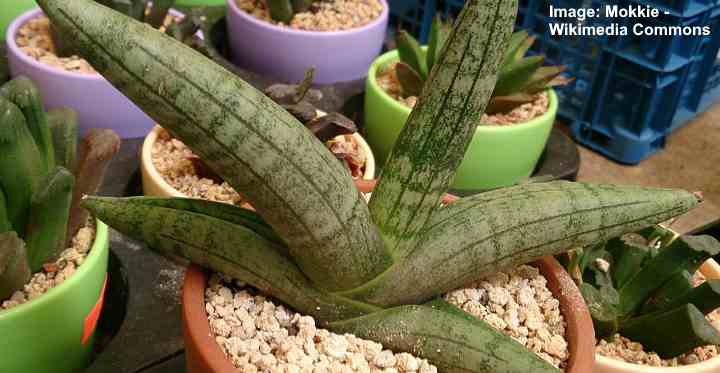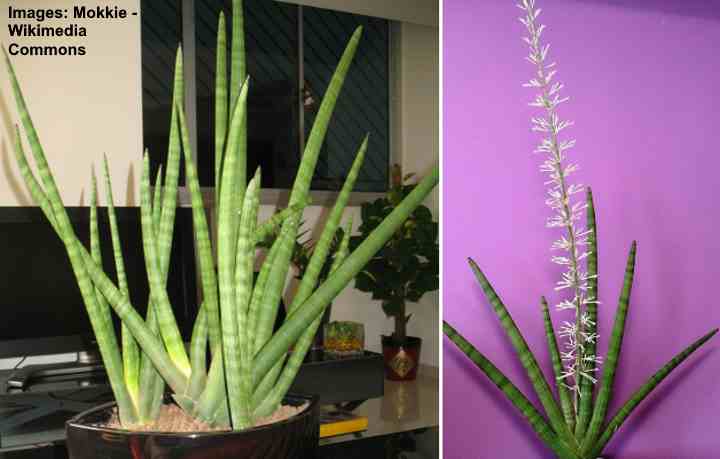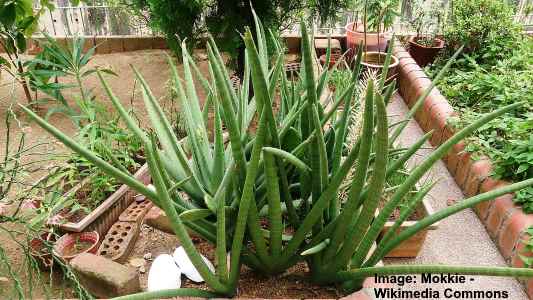Sansevieria ’Starfish’: Caring for Sansevieria Cylindrica (Cylindrical Snake Plant)

Sansevieria ‘Starfish’ (Sansevieria cylindrica ‘Boncel’) is a succulent plant with short, fat, fleshy cylindrical leaves that taper to a point. This snake plant cultivar has leaves with grayish-green color and bands of darker green marks around the leaves.
Many species of Sansevieria have the common name ‘snake plant’—this cultivar also goes by the name cylindrical snake plant. Sansevieria starfish plants are easy-care succulents that need plenty of indirect sunlight and little water.
This article is a guide to growing starfish snake plants at home and how to care for them.
How to Care for Sansevieria Starfish (Starfish Snake Plant)
Sansevieria starfish succulents thrive indoors in bright indirect sunlight and planted in well-draining sandy soil. Cylindrical snake plants need water only when the potting mix is dry. As with most succulent plants, sansevieria starfish plants don’t require extra indoor humidity. Grow in average room temperatures and fertilize monthly during the growing season.
What is a Starfish Sansevieria (Sansevieria cylindrica ‘Boncel’)?

Sansevieria Starfish (Sansevieria cylindrica ‘Boncel’)
Starfish sansevieria is the ‘Boncel’ cultivar of the species Sansevieria cylindrica (cylindrical snake plant). This compact succulent has fat, cylinder-shaped leaves that fan out in a star shape. The name ‘starfish sansevieria’ comes from the fact that the plant looks like a starfish that has been planted halfway in soil.
The full botanical name of starfish sansevieria is Sansevieria cylindrica ‘Boncel‘. For simplicity’s sake, we’ll generally refer to this star shaped cylindrical succulent as starfish sansevieria.
What is Sansevieria ‘Boncellensis’ (Compact Starfish Sansevieria)
Sansevieria cylindrica ‘Boncellensis’ is a miniature version of the starfish sansevieria. This dwarf starfish sansevieria doesn’t grow more than 3” (7.5 cm) tall. The small, compact sansevieria has stumpy, lime-green cylindrical leaves with darker green markings.
Sansevieria ‘Boncellensis’ requires the same care as starfish sansevieria succulents.
Here’s a general explanation about the cylindrical snake plant (Sansevieria cylindrica) and how it differs from its cultivar – starfish sansevieria.
Sansevieria Cylindrica (Cylindrical Snake Plant) Facts

Sansevieria Cylindrica is also called cylindrical snake plant and African spear plant
Cylindrical snake plants are succulents with long fleshy, tubular leaves. The rod-like succulent leaves are a greenish-gray color with darker stripes wrapping around the cylinder leaves. The Sansevieria cylindrica species grows tube-like leaves up to 7 ft. (2 m) tall.

Sansevieria cylindrica succulents
Sansevieria cylindrica is also called African spear plant, cylindrical snake plant, snake cactus plant, and spear sansevieria. Modern botanical classifications also give the plant the scientific name Dracaena angolensis.
These cylindrical snake plants and spear sansevierias are native to Angola.
Cylindrical Snake Plant Vs. Starfish Sansevieria
The main difference between the cylindrical snake plant and the starfish sansevieria is their size and growth habit. The identifying features of starfish sansevieria plants are its fan shape and short, fat pointed cylinder leaves.
The starfish sansevieria is a compact cultivar. It has stiff, fat cylindrical leaves that grow from a basal rosette in a star shape. The plump, fleshy cylindrical leaves only grow up to 20” (50 cm) long. Starfish sansevieria plants have similar leaf markings to the larger cylindrical snake plant.
All types of cylindrical snake plants, including starfish sansevieria, are varieties of flowering succulents. Under ideal growing conditions, starfish sansevierias produce a single flowering stalk up to 3 ft. (1 m) long. The flowers are tiny tubular pinkish-white flowers growing horizontally to the stem.
How to Care for Sansevieria Starfish (Sansevieria Cylindrica ‘Boncel’)
Like most succulent species, starfish sansevieria is easy to care for indoors. All you need to do is grow the sansevieria starfish in a small pot with sandy soil, water it occasionally, and avoid putting it in direct sunlight.
Here are detailed instructions on how to care for starfish sansevieria plants.
Starfish Sansevieria Light Requirements
The best location for sansevieria starfish plants is in a bright room with plenty of natural sunlight. Ideally, compact spear sansevierias grow well on a sunny windowsill. If they grow near a south-facing window, use a sheer curtain to protect the fleshy succulent from the sun’s direct rays.
Although sansevierias are desert plants, the starfish sansevieria cultivars also grow well in partial shade or complete shade. But it’s good to remember that the starfish plant may become leggy or lose its color if deprived of light for too long. Although sansevieria starfish aren’t fast-growing plants, their growth will slow down even more in the dark.
If you notice that the starfish snake plant doesn’t grow well, place it in bright, indirect light.
The Best Soil for Growing Starfish Snake Plant
The best soil for starfish sansevierias is a loamy potting mix with excellent drainage. To make a potting mix, combine two parts regular potting soil, one part perlite, and one part coarse horticultural sand. An ideal potting medium is a potting mix for succulent plants. The soil should be aerated so that it dries fast, and water drains quickly.
The succulent soil mix contains some organic matter—such as peat moss—and inorganic amendments. Peat moss is useful for retaining some moisture. However, you need to add soil amendments such as coarse sand, poultry grit, aquarium gravel, or perlite to ensure adequate drainage.
Starfish sansevierias—like all succulents—can’t stand in soggy, damp soil. The shallow root system quickly starts to rot and decay if the potting medium is continuously wet. Root rot deprives the Sansevieria cylindrica ‘Boncel’ of necessary nutrients and causes fungal diseases that eventually lead to the plant’s death.
How to Water Sansevieria Starfish
Water starfish sansevieria plants only when the soil dries out. In summer, water the succulents every week or two. During winter, water starfish sansevieria infrequently—every month or even less. Waiting for the potting mix to dry before hydrating the soil ensures you don’t overwater the drought-tolerant plant.
To water a sansevieria starfish, first poke your finger in the soil to check for dryness. If the growing medium is bone dry, give the soil a thorough drenching with room-temperature water. Allow all the excess water to drip out before returning the succulent to a sunny location.
The houseplant watering technique of “drench and dry” watering is the best way to care for starfish succulents. Deep root hydration ensures that roots get enough moisture. By allowing the soil to become dry, you help mimic the succulent’s natural growing habitat in hot, arid climates.
Remember, starfish sansevieria plants have thick cylindrical leaves that are excellent for storing moisture. So, the plants will endure many weeks without getting any water. When it comes to watering starfish sansevierias, less watering is better than watering too often.
Temperature Requirements for Healthy Starfish Sansevieria Growth
Starfish sansevierias grow outdoors in hot, arid climates. The good news is that average room temperatures are excellent for growing spear sansevierias indoors. An ideal temperature range is 60°F to 80°F (15°C – 26°C)—as long as you protect the star-shaped succulent from temperature extremes. The minimum temperature for starfish sansevierias is 50°F (10°C).
Generally, if your room is at a comfortable temperature, your sansevieria starfish will grow well.
The right care for cylindrical snake plants means protecting them from fluctuations in temperature. For example, fan snake plants could suffer if they sit in drafts from open windows or air-conditioning airflow. During winter, a sansevieria starfish sitting near a hot radiator could start to wilt from the heat.
Sansevieria cylindrical starfish plants grow in USDA zones 10 and 11. If growing outdoors, make sure the temperature doesn’t drop below 50°F (10°C). If so, bring the containers indoors through the winter until the weather warms the following spring.
Sansevieria Cylindrica Care: Humidity
Starfish succulents require low humidity to thrive well. Species of plants in the genus Sansevieria need dry air and good aeration for best growth. Because household air tends to be dry, you don’t have to worry about indoor humidity. The fleshy fan-shaped succulent gets enough moisture if you water it properly.
How to Fertilize Sansevieria Starfish
Starfish snake plants are not heavy feeders. The plants grow best in sandy soil without many nutrients. However, these spear sansevierias can benefit from monthly fertilization with a succulent fertilizer diluted to half-strength. Only fertilize starfish sansevieria succulents during the growing season, and don’t feed during winter.
Like most varieties of succulents, starfish spear plants are slow-growers. So, over-fertilizing the plants can cause a buildup of mineral salts—which can be just as bad as overwatering. If you decide to supply extra nutrients, choose a suitable organic houseplant fertilizer.
However, you may find with proper care that your starfish snake plant grows fine without additional fertilization.
Repotting Sansevieria Starfish
Starfish sansevieria plants only need repotting every other year or so. Species of sansevieria are slow-growing succulents and grow well when they are rootbound. When repotting a cylindrical snake plant, always choose a pot one or two sizes larger than the current one.
Terracotta pots are the best types of pots for growing sansevieria starfish plants. Because of the large, fat cylinder leaves and fan shape, these succulents can become top-heavy. So, a clay pot will help give some stability. Also, most species of succulents thrive in clay pots because the soil dries faster.
To repot a starfish succulent, remove the fleshy plant from its existing container. Check the roots for signs of decay and trim as necessary. Then, half-fill a new, larger pot with a suitable moist potting mix and plant the starfish sansevieria. Fill the remaining space with soil and press down to stabilize the plant.
After repotting a sansevieria starfish, allow the soil to dry out before watering it. This gives the newly-potted starfish snake plant time to adjust. After that, you can care for the sansevieria starfish as usual.
How to Propagate Starfish Sansevieria
Sansevieria starfish propagation is by dividing the roots called rhizomes. As starfish snake plants grow, smaller ‘baby’ plants called pups grow at the plant’s base. All you need to do is separate the pups from the mother plant and grow it in a new pot.
Another way to propagate Sansevieria cylindrica is by rooting a cut leaf. You should cut off a leaf near to the base of the plant. Lay the cylindrical leaf on a paper towel for a few days to allow the wound to heal or develop a callus. Then, all you have to do is plant the cut leaf in a moist cactus soil mix about 2” to 3” (5 – 7.5 cm) deep. Keep the soil moist for a few weeks until the cutting develops roots.
Pruning African Spear Plant
There is generally no need to prune cylindrical snake plants. The succulents are easy to care for, and their fan-shaped, thick fleshy leaves create attractive ornamental houseplants. The only requirement to prune the starfish sansevieria is to remove yellow leaves or propagate the plant.
Pests Affecting Starfish Sansevieria Growth
Common houseplant pests that affect sansevieria starfish succulents are vine weevils and mealybugs. Vine weevils are small beetles that feed on indoor and outdoor plant roots and leaves. Mealybugs on starfish snake plants look like tiny white bugs that leave behind a white cotton wool-like fuzzy substance on leaves.
Getting rid of houseplant bugs is crucial for starfish succulents to grow well. Fortunately, you don’t have to resort to chemicals or potentially dangerous pesticides to rid your plants of bugs. Many natural, organic insecticides effectively eradicate plant pests even though they don’t contain harmful chemicals.
Use neem oil to get rid of vine weevils or mealybugs. Mix 2 tsp. organic neem oil and 1 tsp. liquid dish soap with 1 quart (1 liter) of lukewarm water in a spray bottle. Shake the anti-bug solution well and spray your sansevieria liberally to kill weevils or mealybugs. Use the neem oil solution once a week to help keep houseplant pests away for good.
If you suspect that vine weevils are in the soil, you can use the neem oil natural pesticide to drench the soil. Use the neem oil solution in place of watering to kill off any weevil grubs living in the soil.
Diseases Affecting Sansevieria Starfish Growth
Starfish sansevieria succulents are not susceptible to disease. The most common types of sansevieria diseases are fungal infections due to root rot. Overwatering sansevierias is usually the reason for roots that start to decay. To prevent snake plant disease, only water the plant when the soil is completely dry.
Is Starfish Sansevieria Poisonous?
Sansevieria starfish plants are poisonous to cats and dogs. According to the ASPCA, plants in the family Agavaceae contain saponins. Ingesting parts of sansevieria plants can cause nausea, vomiting, and diarrhea in dogs and cats.
FAQs About Sansevieria Starfish Care
Starfish sansevieria and African spear plants are easy-care houseplants. However, some issues can affect their growth.
Why is my snake plant Sansevieria cylindrica dying?
Overwatering is the most common reason why Sansevieria cylindrica starfish plants die. Sitting in soggy soil causes root decay and the thick tubular leaves to droop and wilt. To revive a dying starfish sansevieria, hold off watering until the soil dries out.
However, you may need to repot the succulent so you can refresh the potting mix and prune off any dead or decaying roots. If root damage is extensive, it may be too late to save the fan snake plant.
In winter, colder temperatures and too much soil moisture can cause fungal infections to flourish. During winter, when growth is dormant, only water a sansevieria starfish plant when the soil is completely dry. This may mean watering the plant as little as every other month.
Why is my sansevieria starfish leggy?
Starfish sansevieria plants that don’t get enough light become leggy. Although most succulents can survive in the shade, they need some light to grow well. If your starfish succulent has become leggy, move it to a brighter location so that it gets more sunlight.
My starfish sansevieria has curling leaves, how can I stop it?
Your starfish sansevieria may be suffering from a severe lack of water if leaves start to curl. Although starfish snake plants are relatively tolerant of drought, they need some moisture to survive. Especially during the summer, water sansevieria plants by the “drench and dry” method.
Read about other beautiful sansevieria varieties and how to care for them.
Related articles:
- How to Make the Best Potting Soil Mix for Succulent Plants
- Beautiful Types of Succulents and How To Care For Them
